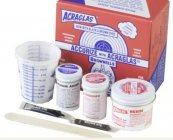AlNyhus
Silver $$ Contributor
This is a stock from a CZ527 in 204R owned by my good pal Randy Robinett. These stocks have a habit of cracking and this one proved to be no exception. External eyeballing showed it might be superficial but further diggin' showed otherwise. We decided it was time for some 'strateg-ery' and 'fixatude-erishness'.
The origin seems have been in the sharp edged bolt notch. You can get a hint of a crack running up the back wall of the notch.

Crack extended down the palm area (black marker to illustrate). From there, it wrapped around the bottom of the grip area.

The crack also extended inside and went across the trigger guard mortise and back to the action screw hole.
At the end of the crack in the palm area, a piece of hardwood dowel should keep the crack from extending.

Three brass pins were epoxied in. The outboard pin went well down the side of the stock and across the crack down the palm area. Initially, the holes were drilled and filled with a thin penetrating epoxy used in wood boat restoration. A heat gun was used to warm the stock and the epoxy was drawn into the crack and to the outside of the stock. After it dried, the holes were opened up and brass pins were epoxied in with the same epoxy.

This view shows how the epoxy migrated across the crack in the bolt notch.

Randy did excellent (no surprise there ) pre and post accuracy testing...interesting, for sure.
) pre and post accuracy testing...interesting, for sure.
Good shootin' -Al
-Al
The origin seems have been in the sharp edged bolt notch. You can get a hint of a crack running up the back wall of the notch.

Crack extended down the palm area (black marker to illustrate). From there, it wrapped around the bottom of the grip area.

The crack also extended inside and went across the trigger guard mortise and back to the action screw hole.
At the end of the crack in the palm area, a piece of hardwood dowel should keep the crack from extending.

Three brass pins were epoxied in. The outboard pin went well down the side of the stock and across the crack down the palm area. Initially, the holes were drilled and filled with a thin penetrating epoxy used in wood boat restoration. A heat gun was used to warm the stock and the epoxy was drawn into the crack and to the outside of the stock. After it dried, the holes were opened up and brass pins were epoxied in with the same epoxy.

This view shows how the epoxy migrated across the crack in the bolt notch.

Randy did excellent (no surprise there
Good shootin'











